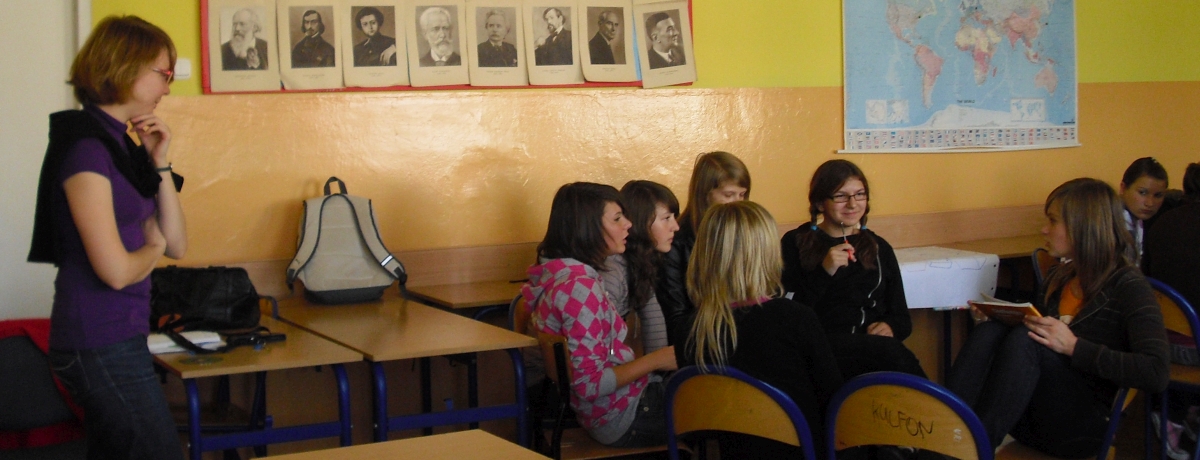Chmielnik
General Kazimierz Tański Junior High School


Honorable Mention at 2009 School of Dialogue Gala
A bulky album in a thick brown cover. On the first pages there are photographs of smiling teenagers. “Our team” – it is written there. The subsequent photographs show young people bent over archival photographs scattered around the classroom, discussing in groups and focused on the texts. And their recollections: “Because of this project, I realized how little do we, people living on the Earth, know about our ancestors. How quickly we let history sink into oblivion. I discovered places in Chmielnik which I will now see in a more mature manner”, said Magda, a 15-year old teenager from Chmielnik. Following the workshops organized by the School of Dialogue, junior high students became aware of the Jewish past of their town.
Subsequent pages of the “Chronicle” show how much involvement these young people put into the program. They printed the titles carefully, took the photos on their own, found pre-war photographs, carefully pasted the descriptions, and wrote interesting texts. “Cemetery”, “Goose Well”, “Synagogue”, “Market Square”, “Cymes Restaurant”, “Ghetto” – these are consecutive chapters of the story of the Jewish Chmielnik. Story of the town where Jews lived from the 16th century. Where they had their own synagogue, with the Talmudic house around it, a cheder, a cemetery.
The map of Chmielnik from the interwar period is enclosed in the Chronicle, where the Small Synagogue, the beit midrash school, the Hedgesz funeral house, a bath and mikveh are marked. A little further: the Lewensztajn goose feeding facility, the Blank sawmill, the brewing plant of Icek Majer Dąb, the Tołemblat water mill. And also: the fields of Mendel, Majer, Gautman. Jews constituted over 80% of the town’s population. They lived in the Market Square, in Szydłowska, Pierzchnicka and Pińczowska Streets. They traded in livestock, butter, tar, iron, pots and cloth, and their fairs in Chmielnik were the biggest ones all around the Governorate.
The Jewish past of Chmielnik proves important to people living there today. Several students, who participated in the program implemented by the School of Dialogue, knew quite a lot about Judaism and the Jewish history of their town. Several already visited Israel. Many of them participated in the annual Days of Jewish Culture in Chmielnik. The Educational and Museum Centre “Shtetl of Świętokrzyski Region” is located in the former synagogue building. A lot is going on in the town. Also due to the workshops organised by the School of Dialogue.

On November 13, 2009, students from General Kazimierz Tański Junior High School invite their older peers to a walking tour around the Jewish Cemetery. First they arrive at the cemetery. They translate and interpret symbols inscribed on matzevot; curious passersby eventually join the tour. They go to see the Goose Well monument where two students explain to participants that before the Second World War and even some time after the war, Chmielnik was known for delicious “Chmielnik goose” and that the Leszman inn was famous for its tasty stiffed goose necks. Today, nobody breeds geese there, but goose specialties are offered at the Cymes Restaurant in the Market Square. Then, they head for the synagogue. In the Chronicle, one may read: “We were struck by emptiness and bareness of the walls. One of the project participants explained how the interior of the synagogue should look”. Today, a few years after completing the project, the synagogue is no longer empty, as the “Shtetl of Świętokrzyski Region” Centre operates in the premises.
The last but one stop of the tour includes the ghetto: “The only thing that is left after the ghetto are the memories of cruelty perpetrated by the Nazis.” The students invited to the tour start to whisper amongst themselves “How come, here in Chmielnik?”
The tour participants go to the Market Square and it seems that they actually see what the authors of the work “Jews in the History of Chmielnik” described: “We stand in the Market Square in Chmielnik on the Friday afternoon and walk along the streets that fall silent. We see giblets slowly disappearing from the stalls in the market, how Fajgel Klarman and Lejbuś Bornsztajn clean their stands. Berek Lewenrajch closes his stand with mineral water and sweets. Window shutters of the shops of Nuta Djament, Katma Garfinkel, Zelika Rozenblum are shutting down. Binem Ogniewicz is selling the very last hallach. Merchants install iron bars on the doors. The town is falling silent and all the traffic is dying out. Women are carrying pots with cholent to the bakery for a dish to grow in hot ovens and be ready for Saturday. Shabbat candles are slowly lit in the windows. The special feast starts. There are no Jews on the streets in Chmielnik”. They are in the imagination of the tour participants, in the hearts of the junior high students and on the pages of accurately prepared album with a title “Chronicle” inscribed in gold.
Due to my participating in the project, I realized how little do we, people living on the Earth, know about our ancestors. How quickly we let history sink into oblivion. I discovered places in Chmielnik at which now I will look again in a more mature manner.I will take friends for this tour. I will tell them a touching story about those who lived here before 1939.
Magdalena, workshops participant

School:
General Kazimierz Tański Junior High School
Honorable mention:
Honorable Mention at 2009 School of Dialogue Gala
Students:
1st and 3rd year students
Teachers:
Paulina Osman, Barbara Rogala-Kupczewska
Educators:
Natalia Pamuła, Anna Szyba
Program co-financed from the funds granted by The Rothschild Foundation Europe.

In appreciation to Friends of the Forum for supporting the School of Dialogue educational program.
